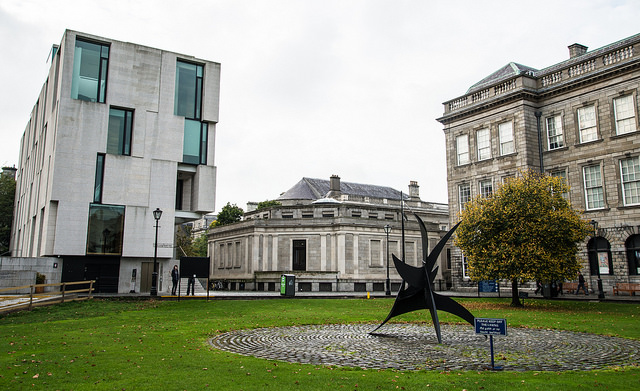
The Irish Network for Gothic Studies held its inaugural symposium yesterday, January 21st. It’s chosen venue, Trinity’s own Long Room Hub, was the a perfect location, making the convention stylish and comfortable. The location was also fitting because of Trinity’s key role in the development of this academic network, with much of the organisation attributed to the Faculty of Arts, Humanities and Social Sciences’s (AHSS) strategic fund and Trinity’s School of English.
The event’s turnout was good, but not great. The Long Room Hub was happily full but, as was noted during the introduction, much of the target audience was taking part in the Dublin Women’s March. Late, but welcome, arrivals continued to filter in as the day went on, and rach presentation was met with engaged and well-thought out questions. This led to some excellent discussions that, heard out of context, would have definitely confused some passers by. Over the course of the day, the room, full of internationally respected academics, debated ideas such as time-travel, ghost dimensions and methods of combating witchcraft. Needless to say, the subject matter of the gothic leaves few dull moments.
The day began with a presentation from Dr Jarlath Killeen, a home-grown international authority on Irish and Victorian gothic fiction and a familiar face around Trinity’s School of English. Killeen’s presentation, entitled “Oscar Wilde, Victorian Ghosts, and the Crisis of Faith”, was an excellent starting point. Killeen provided historical, social and fictional context to Victorian ghost stories and tales of haunted houses all with his signature wit. Killeen is much loved by students who appreciate not only his content but his sense of humour (Twilight and Fifty Shades of Grey have been infamously included in some of his lectures), both of which were present and accounted for during his presentation in the Long Room Hub. Fifty Shades of Grey, mercifully, did not get a mention this time.
Dr Kevin Corstorphine of the University of Hull then led a panel discussing the current state of Irish gothic and horror research. The panel included Dr Andrew Sneddon, Jack Fennell and Dr Tracy Fahey who each presented incredibly different yet complimentary aspects of the gothic. There was a well-defined focus on Ireland’s relationship with the gothic in both domestic and public narratives. Snedden provided hugely intriguing insight to the folklore and history of witchcraft in Ulster. Fennell addressed the representation of ethnic and national identity in archetypal gothic characterisation, he drew interesting connections with the history of colonisation gothic villainy.
Finally, Fahey highlighted an entirely different aspect of contemporary Irish manifestations of the gothic with her presentation entitled “Resurrecting the gothic home in Irish contemporary art practice”. Fahey displayed contemporary Irish fine art in diverse media, showing artists using everything from bricks to digital film to address the notion of the gothic home in Irish culture. Fahey looked at how key stages in Ireland’s history, from famine to mass emigration to religious institutions, have shaped modern anxieties about the concept of home, particularly the woman’s role within it.
The symposium provided an excellent opportunity for academics with a special interest in the gothic and horror genres to enter a live dialogue with leading members of their field. Gothic literature, film, theatre, history and fine art spanning centuries was discussed energetically. To be in a room of like-minded academic entertaining their impassioned field of study is in itself a real treat and an infectious one. The day ended with launch of Inspiring a Mysterious Terror: 200 Years of Joseph Sheridan Le Fanu, edited by Jarlath Killeen and Valeria Cavalli. The book launch was met with a welcome wine reception, an uplifting and light-hearted end to a jam-packed day of engagement with varied manifestations of the gothic in art and fiction.






